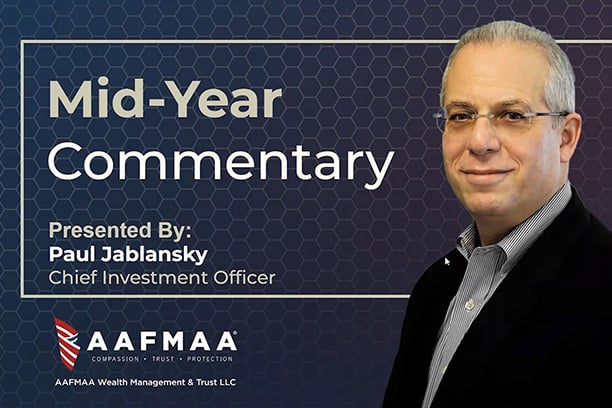

How Will My Legacy Assets Be Distributed?
Presented: July 1, 2022
You’ve spent years making decisions to ensure the safety and stability of your military family. Many Veterans want to know that, when they pass, their loved ones will still be protected and their wishes will be honored. The thoughtful decisions you make today regarding your asset distribution can provide a secure financial future for your loved ones, and preserve your lasting legacy. Tune in to learn the importance of a proactive, detailed estate plan that can ease your fears today and benefit your family tomorrow.
To view this webinar please fill out the form below.
Transcript
How Will My Legacy Assets Be Distributed?
Script:
Slide 1: Title
Hi and welcome, this is Kathleen Lovito, and I will be your host for today’s webinar “How Will My Legacy Assets Be Distributed?”.. Before we begin, here’s a quick background on the association.
Slide 2: Mission
This webinar series is brought to you by AAFMAA Wealth Management & Trust. Our mission is to be the premier provider of financial planning, investment management, and trust services to the American Armed Forces Community.
AAFMAA Wealth Management & Trust is a fully owned subsidiary of AAFMAA. AAFMAA, has proudly served America's Armed Forces since 1879. AAFMAA is a non-profit, tax-exempt (501[c] (23)), member-owned mutual aid association offering life insurance to all branches of the U.S. Armed Forces and their families.
Slide 3: Disclaimer
Also, a few disclaimers: This presentation is educational. It is for general information only and is not specific investment, legal, or tax advice for any of you individually. Do not rely on this presentation alone to guide your investment management decisions. Since each situation is unique, your needs for financial services will differ. For individual advice, please contact us directly. We produce this webinar series in-house with our professional staff as a service to our members to help them better understand the resources that are available to them. We have highlighted here two distinct characteristics that separate AAFMAA Wealth Management & Trust from other service providers: [1] Our fiduciary standard, which requires us to always act in our clients’ best interests, and [2] we exclusively serve the U.S. Armed Forces Community.
Slide 4:
Thanks __Kathleen___ for that great introduction. The focus of this webinar will be to look at the different types of accounts that can hold assets, how those assets are titled (or untitled), how the titling makes a difference, and how those assets fit into a person’s estate plan. My comments will be mostly fact-based, while some will be for general knowledge and all will stem from many years of estate planning and estate settlement experience. It’s not my intent to cover ‘all estate planning concepts,’ but since the focus today is on aspects that contribute to the transfer at death, some estate planning concepts will be discussed. My background is with Florida laws, and could vary depending on other states of domicile. This material should not be considered legal advice nor a substitute for seeking qualified legal advice in your state of residence.
There are a number of ways your estate can be distributed to your heirs after your death. Each allows a different degree of control over distributions, and each poses different challenges and opportunities. Every comprehensive estate planning review should look at the family structure, goals and objectives, special circumstances, your beneficiaries, the assets, titling issues, and the estate planning documents to bring things all together. Without discussing these points, it makes it virtually impossible to develop a roadmap for achieving your estate planning goals. In order to determine how property is transferred at death, we need to start by discussing the thought processes that go into your estate planning decisions. So let’s start by talking about the dreaded ‘Family Dynamics.’
Slide 5:
Estate planning goals and objectives are personal in nature. Determining your distribution goals can be challenging - but quite rewarding in knowing you’re going to make the lives of others better through your generosity. Sometimes husbands and wives don’t agree on the division of their assets (at the second spouse’s death), which can lead to some interesting conversations. No two families are alike and differ in size, needs, personalities, wants, sentimental attachment to things, etc. Some families are pretty easy-going and get along well, while others can be a bit dysfunctional and non-trusting of each other. Everyone tries to plan for all of the ‘what-if’s’ but that’s not always possible. I could write a book about the ‘interesting personalities I’ve seen emerge after mom and dad have passed away.’ I support the saying that ‘once money is involved, all bets are off.’ I have sadly seen too many instances where siblings walked away from a lifetime of good relationships with their brothers and sisters, just because of money. Some people try to control everything from the grave and to a certain extent that can be done with proper planning. However, many have said to me, “I don’t really care what they do with the money after I’m gone.” It simply comes down to personal choices.
Slide 6:
In order to transition assets over to minor children, some people have taken advantage of The Uniform Transfers to Minors Act (UTMA). The concept is fairly straightforward. Rather than creating a revocable or irrevocable trust (that both require legal documents and costs), the transferor (during their lifetime or after their death through Wills and Trusts), can transfer assets into an account controlled by a designated custodian for the benefit of a minor. The custodian is typically the minor’s parent or other adult relative, but a familial relationship is not necessary. When property is transferred into the account, it legally belongs to the minor (and can’t be taken back). The custodian manages, invests, and distributes the funds as the minor’s fiduciary. When the minor reaches legal age (usually 18 in most states), the account terminates, and he or she receives the property outright and free of trust -- unless there are strings attached at the outset.
A growing number of families have taken advantage of special legal documents to provide for the needs of physically or mentally disabled or chronically ill persons (children and adults). With the emergence of the Special Needs Trust in the mid-1970’s, families can make specific provisions for those that already qualify for public assistance benefits from Social Security, Supplemental Security Income, Medicare, etc. With a SNT, they can set aside assets in an irrevocable trust for a person’s benefit that would not disqualify that person from receiving the disability income they are entitled to. In a nutshell, that person can be the primary beneficiary of the income and principal of the SNT (even to the point of using up all of the trust assets), but since they don’t technically own the assets, it doesn’t interfere with them qualifying and receiving public assistance benefits as well. It can be a great win-win! The person(s) setting up the Trust puts language in the document that says how any remaining assets will be distributed at the primary beneficiary’s death or sometimes the beneficiary can direct under their Will.
A guardianship is a legal proceeding involving the circuit courts in which a guardian is appointed to exercise the legal rights of an incapacitated person – or the Ward. I only mention this since it is yet another vehicle for holding and distributing assets during lifetime and after death. Typically, any assets remaining in the guardianship at the time of the Ward's death will be transferred to the Ward's estate, will go through the probate process, and will be distributed according to the Ward’s Last Will and Testament.
Slide 7:
Beneficiary designations are an important part of the estate planning and settlement process. This is potentially the most time-consuming and thought-provoking exercise to go through in estate planning. For some people, this process can take months or even years to work through. Some people leave everything to family members while others choose to leave some to family and some to charities - so their legacy will live on. I’ve had clients leave small amounts to their kids and family members because they want them to learn to be self-sufficient - and then leave the bulk to charity. They truly believe that handing their kids or family members a bunch of money would spoil them and make them lazy. It’s hard to believe, but some of the wealthiest people in America are leaving little to nothing to their children for these reasons. Since estate documents are ‘living/breathing documents,’ they generally can be amended, replaced, or completely done away with during your lifetime. However, at death, those same documents become irrevocable meaning they can no longer be changed – so choose wisely!
Slide 8:
Let’s review the various types of property. Real property means land, homes, buildings, and all other improvements to land. Tangible Personal Property is everything that is not real estate and also includes fixtures, tools, computer equipment, machinery, office equipment, supplies, leasehold improvements, leased equipment, signage, and any other equipment used in a business. Financial assets consist of checking and savings accounts, IRA’s, 401k’s, and investment/brokerage accounts. Although some of these assets are a bit unique and don’t often come into play, I mentioned them because all types of assets can be encountered when settling an estate.
Slide 9:
Some examples of assets that can be “titled” include - homes, automobiles, land, checking and savings accounts, IRAs, 401(k)s, brokerage accounts, deeds, contracts, life insurance, partnerships, annuities, businesses, etc. Then there are assets more difficult to title such as - furniture, clothes, coins, jewelry, stamps, antiques, artwork, collectibles, etc. Depending on how they are titled or untitled, dictates how they are dealt with and distributed when someone passes away.
Slide 10:
A contract for deed, or land contract, is a real property sale where the owner provides the financing for the purchase. The seller keeps the title to the property until the buyer makes the final payment on the agreed amount. There are essentially four basic types of deeds and a few specialized ones based off of those four. The four basic types of deeds, in order of diminishing benefit to the Grantee, are: the Warranty Deed, the Special Warranty Deed, the Fee Simple Deed, and the Quit Claim Deed. Furthermore, there are specialized Deeds such as Personal Representative, Trustee, Guardian, and Life Estate Deeds. When property is owned, it is best to consult with an attorney that specializes in real estate for planning purposes.
What’s the difference between a regular life estate and an enhanced life estate? Well, with a regular life estate deed, the life estate holder must get the consent of the remainder beneficiary(ies) in order to sell, transfer, or mortgage the property during his or her lifetime. A Life Estate is a right given to someone in a deed to live in a property until their death. When they pass away, generally the property will pass to the remainder beneficiaries designated in the deed. Sometimes the lifetime beneficiary is given the power to name the remainder beneficiaries in their documents.
A similar planning tool is referred to as a Lady Bird Deed. It was named after Lady Bird Johnson, because allegedly President Johnson once used this type of deed to convey some land to his wife, Lady Bird. A Lady Bird Deed (or sometimes referred to as an Enhanced Life Estate Deed), allows property to pass automatically to one or more designated recipients at death without the need for probate. In practical terms, the LBD enables a property owner to ‘deed property’ to someone else, but retain full control during their lifetime. The LBD works similarly as the pay-on-death (POD) provisions on a bank account. There are four (4) main benefits of a LBD: 1) probate avoidance; 2) preserve homestead benefits; 3) preserve Medicaid eligibility; and 4) receive a step-up in basis at death. After the death of the owner and the life estate beneficiary, the property passes to the remainder beneficiary. It’s only authorized in Florida and about four other states currently.
Slide 11:
Titling of assets is critical to accomplishing estate goals for distributions at death. Assets that are in sole name pass according to that person’s Last Will and Testament. Assets in joint names generally pass to the surviving spouse, co-owner or co-owners. With regard to real estate, property can be held in: 1. Joint Tenants (meaning assets pass automatically to the surviving co-owners)); 2. Tenancy in Common (meaning assets pass to the surviving spouse or other designee) or 3. Tenancy by the Entireties (assets only pass to the surviving spouse). Assets in the name of a Trust, pass according to the terms of the Trust Agreement. One way to dispose of or distribute untitled assets is by using what’s called a Separate Writing. I will discuss Separate Writings in more detail when we talk about estate documents. To pre-emptively deal with tangible personal property, some people use a Bill of Sale to transfer ownership from themselves to their Revocable Living Trust thereby making those items Trust assets. At the time of their death, those assets avoid probate (as all trust assets do) and would be distributed according to the terms of their Trust Agreement.
I have had several clients over the years maintain multiple residences, vacation homes, and rental properties in multiple states. While it’s nice to be able to take advantage of the year-round seasons that come with those properties, they can be tricky to manage and also potentially expensive to deal with, dispose of, or liquidate after death. I had an estate years ago where he was not a client prior to his death. He had three separate properties in three separate states titled in his sole name. I questioned the legal advice he received because in my opinion, that was potentially the worst-case scenario. When I was appointed as Personal Representative by the court, I had to set up separate estate administrations in each state (one primary and two ancillary administrations) to deal with the properties. It became cumbersome, not to mention expensive to settle, since I had to have legal representation in all three states as well. Most states will allow a Trust to hold title to real estate, businesses, etc. in their states. In doing so, you avoid some of the pitfalls when you have multiple state jurisdictions, multiple estate administrations, and in some cases, state specific taxes that can be significant. I generally advise clients that unless it’s a long-time homestead-type property ”that they really want to keep in the family”, it’s a good idea to look at the short and long-term consequences.
Slide 12
Now let’s talk about the options for estate planning documents. The most common ones include Last Wills and Testament, Revocable Living Trusts, Durable Powers of Attorney, Healthcare Powers of Attorney, Living Wills, and Pre-Need Guardianships. Except for Wills and Trusts, all the other documents become invalid at death so I won’t discuss them specifically as part of this webinar.
A Last Will and Testament is your written set of instructions on how you want your estate to be distributed. If you die without a will, it is called dying “intestate.” The probate court then determines the distribution of your property according to a priority state statute. State laws vary slightly, but the typical progression of most states is that intestate property passes in this order: current surviving spouse, then descendants (children or grandchildren), then parents, then siblings (and children of deceased siblings). In these situations, an Administrator is named by the court. Because intestacy is settled in the probate court, your heirs may have to endure a costly and public probate process that could take six months to a year or more. The approaches used to settle these two types of estate administrations are very different. However, both involve the county courts of jurisdiction as they have authority over all estate administration in their specific counties. It’s always best to have a will prepared by a qualified estate planning attorney versus passing away without a will.
In a prepared Will, the person designated to settle the estate can be called a few things: the Personal Representative (PR); the Executor (male reference); the Executrix (female reference); or Administrator. Regardless of the title, they are the legally designated representative of the estate and accountable to the courts and beneficiaries. The court oversees the estate administration and has to approve of the filings, actions taken, fees, distributions, etc. before they will authorize the closing of the estate. This person or institution (ie. bank or trust company) will act as your PR and will be appointed by the court to carry out your wishes. For an ‘individual’ to qualify to serve as PR, they must be either a state resident, or (regardless of residence), a spouse, sibling, parent, child, or other close relative of the decedent. It’s important to choose a PR carefully as they need a skill set that includes patience, understanding, level headedness, time to devote to the duties and a spirit of cooperation.
Slide 13:
A Separate Writing is a great tool for designating and steering certain items of tangible personal property to beneficiaries so as to avoid probate of those assets and conflicts within your beneficiaries. Tangible personal property consists of physical items that you can pick up and move. These could include items such as pictures, household decorations, collectibles, artwork, coins, stamps and other physical items. It’s a simple document with the heading of separate writing at the top with the ability to list specific items next to the names of the designated beneficiaries. Since some people use this distribution tool extensively and modify their lists often, the law states that the latest dated original is the legally binding document. For a separate writing to be admissible in a probate court, “the writing must be signed and dated by the testator or originator, must describe the items in detail and list the beneficiaries with reasonable certainty.” It’s best to keep the latest original separate writing with the original Will in a safe and secure place.
There are quite a few types of Trusts that you can use as part of your estate plan. The most common is a Revocable Living Trust - or RLT. Others include Testamentary, Irrevocable, Charitable, Credit Shelter, Generation-Skipping, Qualified Personal Residence, and Qualified Terminable Interest Property Trusts. For purposes of this discussion, I’m going to focus on the top two most common types of Trusts: Revocable Living Trusts and Testamentary Trusts.
A trust is a legal arrangement under which the trustee manages property given by the trustor (the originator), for the benefit of a third person (the beneficiary). Trusts can be very effective estate planning tools. The main benefits of an RLT include: 1. Assets avoid probate (they don’t become part of your estate); 2. It’s a vehicle that can take care of you if you can’t take care of yourself; and 3. Most are private and confidential so the whole world won’t know what you own or who your beneficiaries are. You can also benefit from the services of professional asset managers like AWM&T and protect your assets in the event of your incapacity. With certain types of trusts including RLT’s, you may also be able to reduce estate taxes.
If you use an RLT in your estate plan, you can be the trustor (the originator), the trustee, and the beneficiary of your own trust. This allows you to maintain complete control of your estate. For these reasons they are heavily used in estate plans. They are established during your lifetime and require a legal document to be drafted by an estate planning attorney, so there are up-front costs. However, the benefits of keeping assets out of probate can be a huge cost saver. Plus an RLT makes for a smoother transition of assets to or for the benefit of your beneficiaries at death. You will always want to name at least one (if not more) successor trustee(s) in the event one can’t serve. An RLT is sometimes referred to as a ‘fancy will’ because it can do everything a will can do and much more. When you have a funded trust and a will, your trust is your primary document and your will is secondary. The reason being that if most of your assets are trust assets, then the will just plays a supporting or cleanup role dealing with miscellaneous non-trust assets. Since we’re discussing property transfer issues in this webinar, another benefit of an RLT is it can either distribute out the assets or keep them in place for the benefit of future generations. It is a very flexible document and as long as your provisions are not illegal, unethical or immoral, they can be included as provisions in your trust document. Regardless of their state of residence, a Trustee or Successor Trustee can be the trustor (the originator), the surviving spouse, family member, friend or legal representative.
The other main type of trust is a Testamentary Trust -- or sometimes called a Trust under Will. Unlike an RLT, this trust does not require a separate trust agreement thereby saving on the upfront costs. The trust provisions are included in the will – thus the name trust under will. However, those assets don’t avoid probate because they aren’t transferred into the trust until after the estate has been settled. They aren’t private and confidential trusts either because they are part of the will. By law, wills are supposed to be filed with the court when someone passes away and they become a matter of public record - so anyone can look at them. Since the trust continues after the estate settlement, you have to name a trustee in your will. Your trustee can be the same person as your PR or someone completely different.
Slide 14:
We’ve covered a lot of material today. To summarize, assets in sole name are distributed according to your Will. Joint assets generally pass to the surviving joint owner(s). Corporations have succession/ownership documents that spell out what happens in the event of deaths. Assets including IRAs, 401(k)s, life insurance, and annuity contracts require the account holder to designate a beneficiary or beneficiaries so those assets would pass according to those designations. Valid trust documents will always include ultimate distribution provisions. Untitled assets can be dealt with under a separate writing, or lacking that will become part of the residual of the estate and pass according to the provisions in your will.
Here at AWM&T, we pride ourselves on being the premier provider of wealth management, trust, and estate settlement services to the men and women in all branches of the US armed forces. Our focus is to provide the best service and management available anywhere. We adhere to the strictest fiduciary standards of our industry by putting your best interests above all else. We have some of the best and brightest employees in theSG industry. Sometimes with family members you run into issues involving - no time to carry out the duties and conflicts within the family - so a corporate Trustee and PR could be a great fit for your situation.
For example, through our Financial Planning process, we will review your family’s financial plan together with a specific focus on the areas of retirement planning and estate planning. We will examine a number of factors including your current retirement schedules or projections, existing insurance, and estate planning documents.
Slide 15:
When it comes to your investments, our team will provide you with a thorough portfolio review to ensure that your assets are strategically allocated. A custom plan through our Investment Services can increase your generational wealth, so that one day your loved ones, alma mater, or a favorite charity can be blessed with your legacy.
Our AWM&T Relationship Managers would be honored to talk or meet with any active or retired military members to discuss any questions you may have from this webinar, about your current estate plans, or any of the services we provide.
Slide 16: Disclaimer
Slide 17: Thank You






